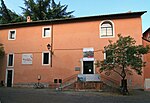Santa Maria in Trastevere
12th-century Roman Catholic church buildings in Italy4th-century churchesBasilica churches in RomeBurial places of popesBurials at Santa Maria in Trastevere ... and 6 more
Churches of Rome (rione Trastevere)MosaicsRoman Catholic churches completed in 1143Roman Catholic churches completed in 1702Romanesque architecture in LazioTitular churches

The Basilica of Santa Maria in Trastevere (Italian: Basilica di Santa Maria in Trastevere); English: Our Lady in Trastevere) is a titular minor basilica in the Trastevere district of Rome, and one of the oldest churches of Rome. The basic floor plan and wall structure of the church date back to the 340s, and much of the structure to 1140–43. The first sanctuary was built in 221 and 227 by Pope Callixtus I and later completed by Pope Julius I. The church has large areas of important mosaics from the late 13th century by Pietro Cavallini.
Excerpt from the Wikipedia article Santa Maria in Trastevere (License: CC BY-SA 3.0, Authors, Images).Santa Maria in Trastevere
Largo Maria Domenica Fumasoni Biondi, Rome Municipio Roma I
Geographical coordinates (GPS) Address External links Nearby Places Show on map
Geographical coordinates (GPS)
| Latitude | Longitude |
|---|---|
| N 41.889444444444 ° | E 12.469722222222 ° |
Address
Basilica di Santa Maria in Trastevere
Largo Maria Domenica Fumasoni Biondi
00120 Rome, Municipio Roma I
Lazio, Italy
Open on Google Maps










